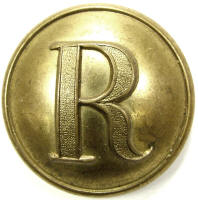
|
The Civil War Relicman, |
|
Winchester, Virginia
USA (changed hands 70 times in the Civil War!). |
|
|
relicman.com. |
Ridgeway Reference Archive, Civil War relics.
Cartridge box for rifled musket, 1864.

|
The Civil War Relicman, |
|
Winchester, Virginia
USA (changed hands 70 times in the Civil War!). |
|
|
relicman.com. |
Ridgeway Reference Archive, Civil War relics.
Cartridge box for rifled musket, 1864.
This is the "Ridgeway Reference Archive", a research tool for educational
purposes only, and is provided at no cost to the reader. Some of the
relics listed are retained in the author's collection, most reside in other
collections and are not owned by the author. None of the items listed in
this section are for sale, please refer to relicman.com sales listings for items
offered for sale. This is a work in progress, I list items as I get to
them, there are many patterns that are not listed yet, this list will be
regularly updated as I get pictures and descriptions for more items. I
will also correct mistakes, so if you see any please tell me.
All items listed are
believed to be original and authentic
to the Civil War or as otherwise described.
Any excavated relics have been recovered from private property with owners
permission.
Any artillery or ordnance relics have been
disarmed and rendered safe.
Any weapons are pre 1898 antique weapons,
and are exempt from Federal regulation, no licenses or permits are required.
This information is
available for research purposes, pictures may be used by permission only.
Federal Cartridge box, Pattern of March, 1864
for .58 cal. elongated ball, maker not determined, with shoulder strap
and plate.
Cartridge box is "Pattern March 1864", this is the last cartridge box to
use the brass "US" boxplate. This pattern has two inside flaps covering
the front implements pouch, and tins. Belt straps are
centered, sewn and riveted. Latch tab is sewn and riveted, brass finial is
pear shaped with a point. Two iron buckles are sewn and riveted.
Manufacturer mark on inside flap not readable, no inspector mark, (Johnson pg. 251). Box measures 7.2in.
X 1.7in. X 5.2in. (for
.58 cal. elongated ball). Brass cartridge plate (O'Donnell plate
491) and shoulder plate (O'Donnell plate 453).
Ref: Johnson pg 215.
|
M0820
Federal Cartridge box, Pattern of March, 1864
for .58 cal. elongated ball, maker not determined, with shoulder
strap and plate. Cartridge box is "Pattern March 1864", this is the last cartridge box to use the brass "US" boxplate. This pattern has two inside flaps covering the front implements pouch, and tins. Belt straps are centered, sewn and riveted. Latch tab is sewn and riveted, brass finial is pear shaped with a point. Two iron buckles are sewn and riveted. Manufacturer mark on inside flap not readable, no inspector mark, (Johnson pg. 251). Box measures 7.2in. X 1.7in. X 5.2in. (for .58 cal. elongated ball). Brass cartridge plate (O'Donnell plate 491) and shoulder plate (O'Donnell plate 453). Rig has been assembled from parts but is correct. Ref: Johnson pg 215. |
Federal Cartridge box, Pattern of July, 1864
Type I for .58 cal. elongated ball, Oliver.
Cartridge box is "Pattern July 1864", Type I, "US" is embossed on the flap, Type
I means there is only one internal flap. The July 1864 boxes discontinued use
of the earlier ornamental brass box plate, replacing it with an oval "US"
embossed on the flap. Type I pattern has inside flap covering
the front implements pouch only. Top of tins are not covered, removal of
this upper flap was introduced with the July 1864 modifications presumably to
expedite production or save costs, it did not work out at all and was quickly
re-instated with the later Type II modifications, so the Type I had a short life. Belt straps are
centered, sewn and riveted. Latch tab is sewn and riveted, brass finial is
pear shaped with a point. Two iron buckles are sewn and riveted.
Manufacturer mark on inside flap
"H W OLIVER / PITTSBURG, PA", no inspector
mark, (Johnson pg. 251). Henry W. Oliver, Pittsburg, Pennsylvania,
had a contract for 20,000 cartridge boxes in 1864. Box measures 7.2in. X 1.7in. X 5.2in. (for
.58 cal. elongated ball).
Ref: Johnson pg 235.
Federal Cartridge box,
Pattern of July, 1864 Type I for .58 cal. elongated ball, maker not determined.
Cartridge box is "Pattern July 1864", Type I, "US" is embossed on the flap, Type
I means there is only one internal flap. The July 1864 boxes discontinued use
of the earlier ornamental brass box plate, replacing it with an oval "US"
embossed on the flap. Type I pattern has inside flap covering
the front implements pouch only. Top of tins are not covered, removal of
this upper flap was introduced with the July 1864 modifications presumably to
expedite production or save costs, it did not work out at all and was quickly
re-instated with the later Type II modifications, so the Type I had a short
life. Belt straps are centered, sewn and riveted.
Manufacturer mark on outside flap not readable, no inspector mark, (Johnson pg.
251). Box measures 7.2in. X 1.7in. X 5.2in. (for .58 cal. elongated ball).
Ref: Johnson pg 235.
|
M0797
Federal Cartridge box, Pattern of July, 1864 Type
I for .58 cal. elongated ball, maker not determined. Ref: Johnson pg 235. |
Federal Cartridge box, Pattern of July, 1864
Type II for .58 cal. elongated ball, Haedrich.
Cartridge box is "Pattern July 1864", Type II, "US" is embossed on the flap,
Type II means there are two internal flaps. The July 1864 boxes
discontinued use of the earlier ornamental brass box plate, replacing it with an
oval "US" embossed on the flap. Type II pattern has inside
flap covering the implements, plus second flap covering the tins, this flap
having been re-instated with Type II following elimination in the Type I design.
This was the last cartridge box for the rifled musket, weapon development was
moving to breech loaders of smaller caliber. Belt straps are centered,
sewn and riveted. Latch tab is sewn and riveted, brass finial is pear
shaped with a point. Two iron buckles are sewn and riveted.
Manufacturer mark on inside flap, "H G HAEDRICH / PHILAD", no inspector mark,
(Johnson pg. 251).
Henry G. Haedrich, Philadelphia, Pennsylvania had contracts for 23,000
infantry accoutrements in 1863, 20,000 in 1864, and 11,000 in 1865 (Bazelon). Box measures 7.2in. X 1.7in. X 5.2in. (for
.58 cal. elongated ball).
Ref: Johnson pg 235.
M0697
Federal Cartridge box, Pattern of July, 1864
Type II for .58 cal. elongated ball, Haedrich.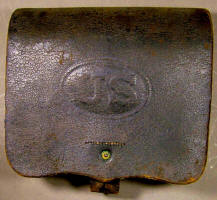
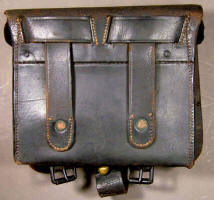
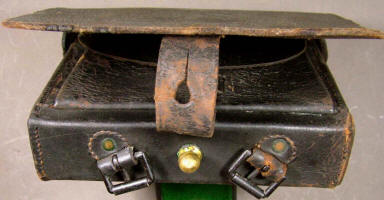

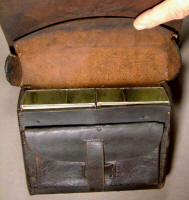
 Cartridge box is "Pattern July 1864", Type II, "US" is embossed on
the flap, Type II means there are two internal flaps. The July 1864
boxes discontinued use of the earlier ornamental brass box plate,
replacing it with an oval "US" embossed on the flap. Type II pattern
has inside flap covering the implements, plus second flap covering the
tins, this flap having been re-instated with Type II following
elimination in the Type I design. This was the last cartridge box for
the rifled musket, weapon development was moving to breech loaders of
smaller caliber. Belt straps are centered, sewn and riveted. Latch tab
is sewn and riveted, brass finial is pear shaped with a point. Two iron
buckles are sewn and riveted. Manufacturer mark on inside flap, "H G
HAEDRICH / PHILAD", no inspector mark, (Johnson pg. 251). Henry G. Haedrich, Philadelphia, Pennsylvania had contracts for 23,000
infantry accoutrements in 1863, 20,000 in 1864, and 11,000 in 1865 (Bazelon). Box measures 7.2in. X 1.7in. X 5.2in. (for
.58 cal. elongated ball). Belt loops intact, fastening tab intact, both
buckles intact, both tins intact, inside flaps are intact, front flap
with "US" intact, leather is flexible, high grade example. Cartridge box is "Pattern July 1864", Type II, "US" is embossed on
the flap, Type II means there are two internal flaps. The July 1864
boxes discontinued use of the earlier ornamental brass box plate,
replacing it with an oval "US" embossed on the flap. Type II pattern
has inside flap covering the implements, plus second flap covering the
tins, this flap having been re-instated with Type II following
elimination in the Type I design. This was the last cartridge box for
the rifled musket, weapon development was moving to breech loaders of
smaller caliber. Belt straps are centered, sewn and riveted. Latch tab
is sewn and riveted, brass finial is pear shaped with a point. Two iron
buckles are sewn and riveted. Manufacturer mark on inside flap, "H G
HAEDRICH / PHILAD", no inspector mark, (Johnson pg. 251). Henry G. Haedrich, Philadelphia, Pennsylvania had contracts for 23,000
infantry accoutrements in 1863, 20,000 in 1864, and 11,000 in 1865 (Bazelon). Box measures 7.2in. X 1.7in. X 5.2in. (for
.58 cal. elongated ball). Belt loops intact, fastening tab intact, both
buckles intact, both tins intact, inside flaps are intact, front flap
with "US" intact, leather is flexible, high grade example.Ref: Johnson pg 235. |
Federal Cartridge box, Pattern of July, 1864
Type II for .58 cal. elongated ball, Metzger and Hartzell.
Cartridge box is "Pattern July 1864",
Type II, "US" is embossed on the flap, Type II means
there are two internal flaps. The July 1864 boxes discontinued use of
the earlier ornamental brass box plate,
replacing it with an oval "US" embossed on the flap. Type II
pattern has inside flap covering the implements, plus second flap covering
the tins, this flap having been re-instated with Type II following elimination
in the Type I design. This was the last cartridge box for the rifled
musket, weapon development was moving to breech loaders of smaller caliber.
Belt straps are centered, sewn and riveted. Latch tab is sewn and riveted,
brass finial is pear shaped with a point. Two iron buckles are sewn and
riveted. Manufacturer mark on inside flap "E METZGER /
PHILA", inspector mark on inside flap: "H. H.
HARTZELL / SUB INSPECTOR / U.S. ORD DEPT ", (Johnson
pg. 251). Emanuel Metzger, Philadelphia Pennsylvania
received a contract to supply 18,000 cartridge boxes in 1864 and 1865 (Bazelon).
Box measures 7.2in. X 1.7in. X 5.2in. (for
.58 cal. elongated ball).
Ref: Johnson pg 235.
Federal Cartridge box, Pattern of July, 1864
Type II for .58 cal. elongated ball, Metzger and Jones.
Cartridge box is "Pattern July 1864",
Type II, "US" is embossed on the flap, Type II means
there are two internal flaps. The July 1864 boxes discontinued use of
the earlier ornamental brass box plate,
replacing it with an oval "US" embossed on the flap. Type II
pattern has inside flap covering the implements, plus second flap covering
the tins, this flap having been re-instated with Type II following elimination
in the Type I design. This was the last cartridge box for the rifled
musket, weapon development was moving to breech loaders of smaller caliber.
Belt straps are centered, sewn and riveted. Latch tab is sewn and riveted,
brass finial is pear shaped with a point. Two iron buckles are sewn and
riveted. Manufacturer mark on inside flap "E METZGER /
PHILA", inspector mark on inside flap: "W. H.
JONES / SUB INSPECTOR / U.S. ORD DEPT ", (Johnson
pg. 251). Emanuel Metzger, Philadelphia Pennsylvania
received a contract to supply 18,000 cartridge boxes in 1864 and 1865 (Bazelon).
Box measures 7.2in. X 1.7in. X 5.2in. (for
.58 cal. elongated ball).
Ref: Johnson pg 235.
Federal Cartridge box, Pattern of July, 1864
Type II for .58 cal. elongated ball, Nece and Laidley.
Cartridge box is "Pattern July 1864",
Type II, "US" is embossed on the flap, Type II means
there are two internal flaps. The July 1864 boxes discontinued use of
the earlier ornamental brass box plate,
replacing it with an oval "US" embossed on the flap. Type II
pattern has inside flap covering the implements, plus second flap covering
the tins, this flap having been re-instated with Type II following elimination
in the Type I design. This was the last cartridge box for the rifled
musket, weapon development was moving to breech loaders of smaller caliber.
Belt straps are centered, sewn and riveted. Latch tab is sewn and riveted,
brass finial is pear shaped with a point. Two iron buckles are sewn and
riveted. Latch tab is sewn and riveted, brass finial is pear shaped
with a point. Two iron buckles are sewn and riveted.
Manufacturer mark on inside flap "R NECE", and inspector mark "A D LAIDLEY/
SUB INSPECTOR / ORD. DEPT", (Johnson pg. 251).
Reuben Nece, Philadelphia Pennsylvania received a contract to supply 33,000
cartridge boxes in from 1863 to 1865, (Bazelon).
Box measures 7.2in. X 1.7in. X 5.2in. (for
.58 cal. elongated ball).
Ref: Johnson pg 235.
Federal Cartridge box, Pattern of July, 1864
Type II for .58 cal. elongated ball, Nece and Sniffen.
Cartridge box is "Pattern July 1864",
Type II, "US" is embossed on the flap, Type II means
there are two internal flaps. The July 1864 boxes discontinued use of
the earlier ornamental brass box plate,
replacing it with an oval "US" embossed on the flap. Type II
pattern has inside flap covering the implements, plus second flap covering
the tins, this flap having been re-instated with Type II following elimination
in the Type I design. This was the last cartridge box for the rifled
musket, weapon development was moving to breech loaders of smaller caliber.
Belt straps are centered, sewn and riveted. Latch tab is sewn and riveted,
brass finial is pear shaped with a point. Two iron buckles are sewn and
riveted. Latch tab is sewn and riveted, brass finial is pear shaped
with a point. Two iron buckles are sewn and riveted.
Inspector mark on inside flap,
"F. A. SNIFFEN / US / ORDNANCE / SUB INSPECTOR" and manufacturer mark, "R. NECE
/ PHILAD", (Johnson pg. 251).
Reuben Nece, Philadelphia Pennsylvania received a contract to supply 33,000
cartridge boxes in from 1863 to 1865, (Bazelon).
Box measures 7.2in. X 1.7in. X 5.2in. (for
.58 cal. elongated ball).
Ref: Johnson pg 235.
M0682
Federal Cartridge box, Pattern of July, 1864
Type II for .58 cal. elongated ball, Nece and Sniffen.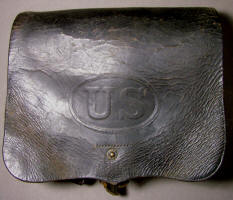
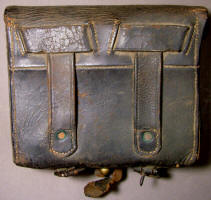

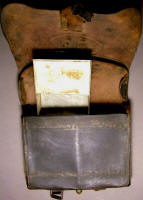
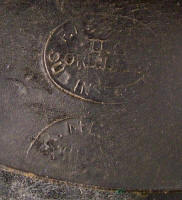 Cartridge box is "Pattern July 1864",
Type II, "US" is embossed on the flap, Type II means
there are two internal flaps. The July 1864 boxes discontinued use of
the earlier ornamental brass box plate,
replacing it with an oval "US" embossed on the flap. Type II
pattern has inside flap covering the implements, plus second flap covering
the tins, this flap having been re-instated with Type II following
elimination in the Type I design. This was the last cartridge box
for the rifled musket, weapon development was moving to breech loaders
of smaller caliber. Belt straps are centered, sewn and riveted.
Latch tab is sewn and riveted, brass finial is pear shaped with a point.
Two iron buckles are sewn and riveted.
Inspector mark on inside flap, "F. A. SNIFFEN / US / ORDNANCE / SUB
INSPECTOR" and manufacturer mark, "R. NECE / PHILAD", (Johnson pg.
251). Reuben Nece, Philadelphia Pennsylvania received a contract
to supply 33,000 cartridge boxes in from 1863 to 1865, (Bazelon). Box measures 7.2in. X 1.7in. X 5.2in. (for
.58 cal. elongated ball). Belt loops intact, fastening tab intact with a
tear, finial intact, both buckles intact, one tin is missing, inside
flaps are intact, front flap with embossed "US" intact, leather is
flexible.
Cartridge box is "Pattern July 1864",
Type II, "US" is embossed on the flap, Type II means
there are two internal flaps. The July 1864 boxes discontinued use of
the earlier ornamental brass box plate,
replacing it with an oval "US" embossed on the flap. Type II
pattern has inside flap covering the implements, plus second flap covering
the tins, this flap having been re-instated with Type II following
elimination in the Type I design. This was the last cartridge box
for the rifled musket, weapon development was moving to breech loaders
of smaller caliber. Belt straps are centered, sewn and riveted.
Latch tab is sewn and riveted, brass finial is pear shaped with a point.
Two iron buckles are sewn and riveted.
Inspector mark on inside flap, "F. A. SNIFFEN / US / ORDNANCE / SUB
INSPECTOR" and manufacturer mark, "R. NECE / PHILAD", (Johnson pg.
251). Reuben Nece, Philadelphia Pennsylvania received a contract
to supply 33,000 cartridge boxes in from 1863 to 1865, (Bazelon). Box measures 7.2in. X 1.7in. X 5.2in. (for
.58 cal. elongated ball). Belt loops intact, fastening tab intact with a
tear, finial intact, both buckles intact, one tin is missing, inside
flaps are intact, front flap with embossed "US" intact, leather is
flexible.Ref: Johnson pg 235. |
Federal Cartridge box, Pattern of July, 1864
Type II for .58 cal. elongated ball, Young and White.
Cartridge box is "Pattern July 1864",
Type II, "US" is embossed on the flap, Type II means
there are two internal flaps. The July 1864 boxes discontinued use of
the earlier ornamental brass box plate,
replacing it with an oval "US" embossed on the flap. Type II
pattern has inside flap covering the implements, plus second flap covering
the tins, this flap having been re-instated with Type II following elimination
in the Type I design. This was the last cartridge box for the rifled
musket, weapon development was moving to breech loaders of smaller caliber.
Belt straps are centered, sewn and riveted. Latch tab is sewn and riveted,
brass finial is pear shaped with a point. Two iron buckles are sewn and
riveted.
Manufacturer mark on the back side: "S H YOUNG & CO / NEWARK NJ" and inspector
mark on front flap: "R WHITE / SUB INSPECTOR", (Johnson pg. 251).
Stephen H. Young, Newark, New Jersey, received a contract for 10,000
sets of infantry accoutrements
in 1865, (Bazelon). Box measures 7.2in. X 1.7in. X 5.2in. (for
.58 cal. elongated ball).
Ref: Johnson pg 235.
Federal Cartridge box, Pattern of July, 1864
Type II for .58 cal. elongated ball, Young and Miller.
Cartridge box is "Pattern July 1864",
Type II, "US" is embossed on the flap, Type II means
there are two internal flaps. The July 1864 boxes discontinued use of
the earlier ornamental brass box plate,
replacing it with an oval "US" embossed on the flap. Type II
pattern has inside flap covering the implements, plus second flap covering
the tins, this flap having been re-instated with Type II following elimination
in the Type I design. This was the last cartridge box for the rifled
musket, weapon development was moving to breech loaders of smaller caliber.
Belt straps are centered, sewn and riveted. Latch tab is sewn and riveted,
brass finial is pear shaped with a point. Two iron buckles are sewn and
riveted.
Manufacturer mark on the back side: "S H YOUNG & CO / NEWARK NJ" and inspector
mark on front flap: "JC MILLER PHILADELPHIA", (Johnson pg. 251).
Stephen H. Young, Newark, New Jersey, received a contract for 10,000
sets of infantry accoutrements
in 1865, (Bazelon). Box measures 7.2in. X 1.7in. X 5.2in. (for
.58 cal. elongated ball).
Ref: Johnson pg 235.
Federal Cartridge box, Pattern of July, 1864
Type II for .58 cal. elongated ball, Watertown Arsenal 1865, cartridge and cap
box.
Cartridge box is "Pattern July 1864",
Type II, "US" is embossed on the flap, Type II means
there are two internal flaps. The July 1864 boxes discontinued use of
the earlier ornamental brass box plate,
replacing it with an oval "US" embossed on the flap. Type II
pattern has inside flap covering the implements, plus second flap covering
the tins, this flap having been re-instated with Type II following elimination
in the Type I design. This was the last cartridge box for the rifled
musket, weapon development was moving to breech loaders of smaller caliber.
Belt straps are centered, sewn and riveted. Latch tab is sewn and riveted,
brass finial is pear shaped with a point. Two iron buckles are sewn and
riveted. Latch tab is sewn and riveted, brass finial is pear shaped
with a point. Two iron buckles are sewn and riveted.
Both boxes are marked, "WATERTOWN ARSENAL 1865
, (Johnson pg. 251). Box measures 7.2in. X 1.7in. X 5.2in. (for
.58 cal. elongated ball).
Ref: Johnson pg 235. (cartridge box
and cap box)
|
M0770 Federal Cartridge box, Pattern of July, 1864
Type II for .58 cal. elongated ball, Watertown Arsenal 1865, cartridge and cap
box. Ref: Johnson pg 235. (cartridge box and cap box) |
Federal Cartridge box, Pattern of July, 1864
Type II for .69 cal. elongated ball, Nece and Sniffen.
Cartridge box is "Pattern July 1864",
Type II, "US" is embossed on the flap, Type II means
there are two internal flaps. The July 1864 boxes discontinued use of
the earlier ornamental brass box plate,
replacing it with an oval "US" embossed on the flap. Type II
pattern has inside flap covering the implements, plus second flap covering
the tins, this flap having been re-instated with Type II following elimination
in the Type I design. This was the last cartridge box for the rifled
musket, weapon development was moving to breech loaders of smaller caliber.
Belt straps are centered, sewn and riveted. Latch tab is sewn and riveted,
brass finial is pear shaped with a point. Two iron buckles are sewn and
riveted.
Inspector mark on inside flap, "F. A. SNIFFEN / US / ORDNANCE / SUB INSPECTOR"
and manufacturer mark, "R. NECE / PHILAD", (Johnson pg. 251).
Reuben Nece, Philadelphia Pennsylvania received a contract to supply 33,000
cartridge boxes in from 1863 to 1865, (Bazelon). Box
measures 8.2in X 1.8in X 4.8in (for .69 cal. elongated ball).
Ref: Johnson pg 235.
M0696
Federal Cartridge box, Pattern of July, 1864
Type II for .69 cal. elongated ball, Nece and Sniffen.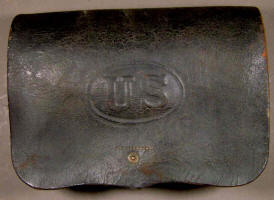
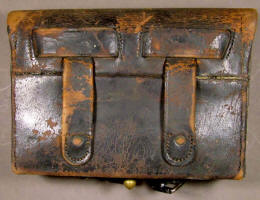
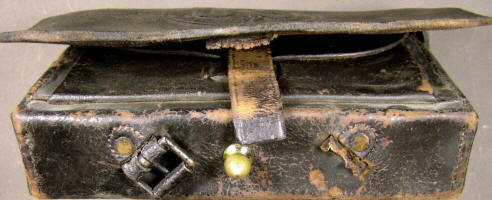
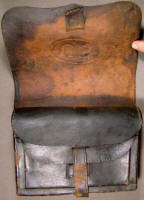
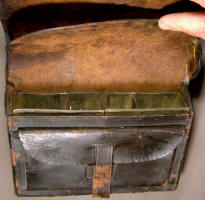 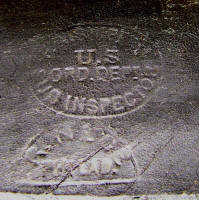 Cartridge box is "Pattern July 1864",
Type II, "US" is embossed on the flap, Type II means
there are two internal flaps. The July 1864 boxes discontinued use of
the earlier ornamental brass box plate,
replacing it with an oval "US" embossed on the flap. Type II
pattern has inside flap covering the implements, plus second flap covering
the tins, this flap having been re-instated with Type II following
elimination in the Type I design. This was the last cartridge box
for the rifled musket, weapon development was moving to breech loaders
of smaller caliber. Belt straps are centered, sewn and riveted.
Latch tab is sewn and riveted, brass finial is pear shaped with a point.
Two iron buckles are sewn and riveted.
Inspector mark on inside flap, "F. A. SNIFFEN / US / ORDNANCE / SUB
INSPECTOR" and manufacturer mark, "R. NECE / PHILAD", (Johnson pg.
251). Reuben Nece, Philadelphia Pennsylvania received a contract
to supply 33,000 cartridge boxes in from 1863 to 1865, (Bazelon).Box measures 8.2in X 1.8in X 4.8in (for .69 cal. elongated
ball). Belt loops intact, fastening tab is partial, finial intact,
both buckles present one is loose, tins intact, inside flaps are intact,
front flap with embossed "US" intact, leather is flexible.
Cartridge box is "Pattern July 1864",
Type II, "US" is embossed on the flap, Type II means
there are two internal flaps. The July 1864 boxes discontinued use of
the earlier ornamental brass box plate,
replacing it with an oval "US" embossed on the flap. Type II
pattern has inside flap covering the implements, plus second flap covering
the tins, this flap having been re-instated with Type II following
elimination in the Type I design. This was the last cartridge box
for the rifled musket, weapon development was moving to breech loaders
of smaller caliber. Belt straps are centered, sewn and riveted.
Latch tab is sewn and riveted, brass finial is pear shaped with a point.
Two iron buckles are sewn and riveted.
Inspector mark on inside flap, "F. A. SNIFFEN / US / ORDNANCE / SUB
INSPECTOR" and manufacturer mark, "R. NECE / PHILAD", (Johnson pg.
251). Reuben Nece, Philadelphia Pennsylvania received a contract
to supply 33,000 cartridge boxes in from 1863 to 1865, (Bazelon).Box measures 8.2in X 1.8in X 4.8in (for .69 cal. elongated
ball). Belt loops intact, fastening tab is partial, finial intact,
both buckles present one is loose, tins intact, inside flaps are intact,
front flap with embossed "US" intact, leather is flexible. Ref: Johnson pg 235. |
Federal Cartridge box, Pattern of July, 1864 Type II for .58 cal.
elongated ball, maker not determined.
Cartridge box is "Pattern July 1864", Type II, "US" is embossed on the flap,
Type II means there are two internal flaps. The July 1864 boxes
discontinued use of the earlier ornamental brass box plate, replacing it with an
oval "US" embossed on the flap. Type II pattern has inside
flap covering the implements, plus second flap covering the tins, this flap
having been re-instated with Type II following elimination in the Type I design.
This was the last cartridge box for the rifled musket, weapon development was
moving to breech loaders of smaller caliber. Belt straps are centered,
sewn and riveted. Latch tab is sewn and riveted, brass finial is pear
shaped with a point. Two iron buckles are sewn and riveted.
Manufacturer mark appears on the lower left side of the outer flap in an oval
but is not readable. Box measures 7.2in. X 1.7in. X 5.2in. (for .58 cal.
elongated ball).
Ref: Johnson pg 235.